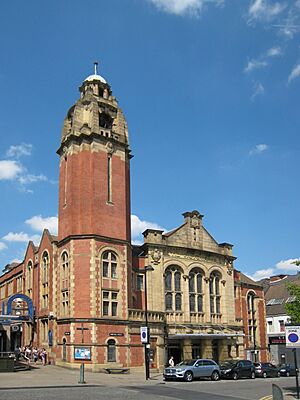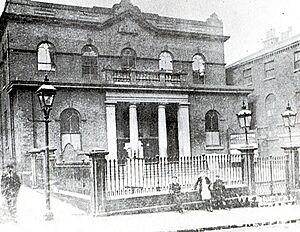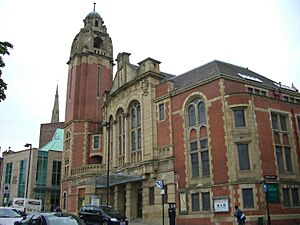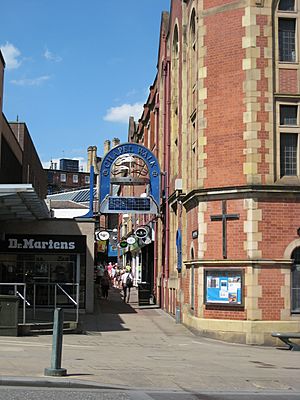Victoria Hall, Sheffield facts for kids
Victoria Hall is a special church for Methodists in Sheffield city centre. You can find it on Norfolk Street. It's the most important Methodist building in Sheffield and is a Grade II listed building, which means it's a very old and important building protected by law.
This large building has many rooms. It stands between two smaller streets called Chapel Walk and George Street. The main entrance to the church is on Norfolk Street, but there's another entrance on Chapel Walk for offices.
Contents
History of Victoria Hall
Early Days: The First Chapels
Methodism started in South Yorkshire way back in 1742. That's when John Wesley, a famous religious leader, came to Sheffield. He was on a preaching trip and started the first group of Methodists in the city.
They first met in a small wooden building in Cheyney Square. This spot is now where the Town Hall stands. In 1743, during a service led by Charles Wesley (John's brother), the meeting house was damaged during a disturbance.
Because of this, a new chapel was built on Mulberry Street. The local leaders paid for it because they hadn't kept the peace. Methodists used this chapel until 1779.
Then, the Norfolk Street Wesleyan Chapel was finished. This new chapel was built on the same spot where Victoria Hall is today. John Wesley, who was 77 years old, opened it in 1780. He said it was "One of the largest in the Kingdom!" He even gave the new building a set of silver cups for communion.
The chapel was updated in 1875, but it was still taken down in 1906. This was to make room for a bigger and more impressive building. The old building closed its doors for the last time on May 13, 1906.
Building the New Victoria Hall
On September 26, 1906, the first stone for the new Victoria Hall was laid. This was followed by a special lunch at the Cutlers Hall. The new Hall officially opened on Thursday, September 24, 1908.
It cost more than £40,000 to build, which was a huge amount of money back then! But the Methodist group managed to pay off this debt in just three years. The total cost included buying more land. A Sheffield businessman named Thomas Cole even gave some land to make the church site bigger.
The first design for the Hall was by Waddington Son & Dunkerley. But much of the final design was changed by William John Hale in 1908. Hale mixed two styles: Gothic and Arts and Crafts. He was key in designing the large, fancy top of the tower, which looks like Baroque style. The detailed carvings on the hall were made by Alfred and William Tory. You can even see pictures of the Wesley brothers in the design.
The new hall was part of a big plan by the Methodist church called the "Forward Movement." This idea came from Hugh Price Hughes. He wanted the church to reach out to poor people across the country. This led to many large "Central Halls" being built in big cities in Britain.
One of the Hall's first big achievements was setting up the Sheffield Mission Labour Yard. This yard helped many people who didn't have jobs at the time. By June 1909, it had given almost 6,000 men work for over 5,900 days. The yard closed in 1915 because the First World War meant almost everyone had a job.
Victoria Hall has always had strong links with trade unions. In September 1909, the Trade Union Congress held its yearly meeting there. Since then, many different unions have had meetings at the Hall. In its early days, the area around the Hall was very busy. Thousands of young people came to Sunday School, Scouting, Girl Guides, and Boys' Brigade activities there.
Victoria Hall During Wartime
During the First World War, Victoria Hall opened its doors to help soldiers. After the war ended, King George V and Queen Mary visited Sheffield in 1919. The King gave medals to soldiers returning from the war from the stage inside the church.
During the Great Depression (a time when many people lost their jobs and money), the Hall helped needy children by giving them free breakfasts. It also gave out food packages and helped people who were unemployed.
Before the Sheffield City Hall was finished in 1932, Victoria Hall was the main place for concerts in the city. Many famous orchestras played music there. In the Second World War, the Hall survived the Sheffield Blitz air raids in December 1940. Even after the bombings, over 200 people gathered to sing The Messiah on the Sunday after the raids. On May 9, 1941, part of Victoria Hall was turned into a place for soldiers to rest, with 20 beds. This was later made bigger to hold 35 beds.
Victoria Hall Today
Today, Victoria Hall is in an important spot in the city centre. It's across from Tudor Square and very close to the Crucible and Lyceum theatres.
Besides being a place of worship, the Hall is used by different groups that help people. For example, they provide meals for people who are homeless. It's also a popular place for classical music concerts. You can even rent out a function room for your own events!





